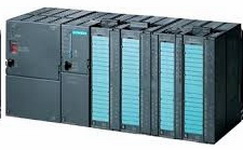S7-300 Modular controller for building systems of low and medium performance
Характеристики товара
• Modular programmable controller for solving automation tasks of low and medium complexity.
• A wide range of modules for maximum adaptation to the requirements of the task at hand.
• Use of distributed I / O structures and easy inclusion in network configurations.
• Convenient design and work with natural cooling.
• Free build-up of functionality while modernizing the control system.
• High power thanks to a large number of built-in functions.
Design Features
S7-300 programmable controllers may include:
• Central processing unit (CPU). Depending on the complexity of the tasks to be solved, more than 20 types of central processors can be used in a programmable controller.
• Power supplies (PS) for powering the controller from AC or DC power.
• Signal modules (SM), designed for input and output of discrete and analog signals, including FailSafe and modules with built-in Ex-barriers. Domestic GOST graduations of resistance thermometers and thermocouples are supported.
• Communication processors (CP) – intelligent modules that perform offline processing of communication tasks in industrial networks AS-Interface, PROFIBUS, Industrial Ethernet, PROFINET and PtP communication systems. The use of downloadable drivers for CP 341 allows you to expand the communication capabilities of the controller by supporting data exchange in MODBUS RTU and Data Highway networks. To organize modem communication as part of the S7-300, communication modules of the SINAUT ST7 family can be used.
• Functional Modules (FM) – intelligent modules equipped with a built-in microprocessor and capable of performing tasks of automatic regulation, weighing, positioning, high-speed counting, motion control, etc. A number of functional modules are able to continue to fulfill the tasks assigned to them even if the central processor stops.
• Interface modules (IM) for connecting expansion racks to the base unit of the controller, which allows using up to 32 modules for various purposes in the local I / O system. IM 365 modules allow you to create 2-, IM 360 and IM 361 modules – 2-, 3- and 4-row configurations.
The controller design is highly flexible and easy to maintain:
• All modules are mounted on the S7-300 profile bus and locked in working positions by screws. The integration of the modules into a single system is carried out using bus connectors (included in the delivery package of each module) installed on the back of the case.
• Arbitrary order of placement of modules in mounting racks. Fixed footprints are occupied only by PS, CPU and IM modules. The presence of removable front connectors (ordered separately), which allows for quick replacement of modules without dismantling their external circuits and simplifying the operation of connecting external circuits of modules. Mechanical coding of the front connectors eliminates the possibility of errors when replacing modules.
• The use of flexible and modular TOP Connect connectors, greatly simplifying installation work and reducing their execution time
Central Processing Units
All S7-300 CPUs are characterized by the following indicators:
• high speed,
• downloadable memory in the form of a micro MMC memory card with a capacity of up to 8 MB,
• developed communication capabilities, simultaneous support of a large number of active communication connections,
• operation without a backup battery.
MMC is used to load a program, save data during a power failure in the CPU, store a project archive with a symbol table and comments, and also for archiving intermediate data.
The central processors CPU 3xxC and CPU 31xT-2 DP are equipped with a set of built-in inputs and outputs, and their operating system is supplemented with support for technological functions, which allows them to be used as ready-made control units.
A typical set of built-in technological functions allows you to solve the problems of high-speed counting, measuring the frequency or duration of a period, PID control, positioning, transferring some of the digital outputs to pulse mode. All S7-300 CPUs are equipped with an integrated MPI interface, which is used for programming, diagnostics, and building simple network structures. In the CPU 317, the first integrated interface has a dual purpose and can be used to connect to either an MPI network or a PROFIBUS DP network.
A number of central processors have a second built-in interface:
• CPU 31 … -2 DP have a PROFIBUS DP master / slave interface;
• CPU 31 … C-2 PtP have an interface for organizing PtP communication;
• CPU 31 … – … PN / DP are equipped with an Industrial Ethernet interface that supports the PROFInet standard;
• CPU 31 … T-2 DP equipped with PROFIBUS interface DP / Drive, designed to exchange data and synchronize the operation of frequency converters that perform the functions of DP slaves.
The central processor instruction system includes more than 350 instructions and allows you to perform:
• Logical operations, operations of shift, rotation, additions, operations of comparison, conversion of data types, operations with timers and counters.
• Arithmetic operations with fixed and floating point, square root extraction, logarithmic operations, trigonometric functions, operations with brackets.
• Operations of loading, saving and moving data, operations of transitions, call blocks, and other operations.
For programming and configuration of the S7-300, the STEP 7 package is used.
In addition, the entire Runtime suite of software, as well as a wide range of design tools, can also be used to program the S7-300 controllers.


